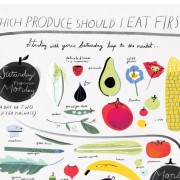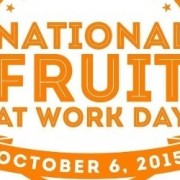Food Trends To Know In 2016!

(Photo: Flickr user Wim de Jong)
When looking ahead to the trends that will matter in 2016, Datassential focused on both the macro-level food trends that are redefining the industry, as well as the micro trends that are impacting specific ingredients or segments. We looked at the major trends that are influencing the culture and economy overall, from generational shifts to economic drivers, and combined it with
Datassential’s industry-defining data from services like MenuTrends and LOCAL to understand how the food industry will be affected in the year ahead. These are the trends you need to know in 2016:
MACRO TRENDS:
- Don’t call it ethnic: For groups like Generation Z (born 1997 or later), which will comprise 40% of the population by 2020, ethnic cuisine is their cuisine. Not only is this a multicultural generation itself, but overall this generation is more likely to prefer cuisines like Korean or Vietnamese to “American” or Southern. They don’t go out to eat for cuisines like “Mexican” or “Japanese,” they simply go out for tacos and ramen.
- Foodservice comes home: Next-generation consumers are not only comfortable with technology, but for groups like Generation Z, they are dependent on it. Now they are using it to bring the best parts of eating out into the home, with a wealth of new on-demand delivery services and meal kit startups. Investors are taking notice — it’s estimated that over a billion dollars will be invested in the space this year, up from $600 million in 2014.
- Hyper regional: In the 80s it was all about understanding national trends, in the 2000s we drilled down to focus on major regional flavors, and now the focus is on connecting with consumers through truly local foods, driven by small metro areas. In fact, small geographical distances can have a huge impact on what consumers see and want — Datassential’s LOCAL tool crunches the numbers on which foods index higher for particular cities or metros – Italian beef in Chicago, green chile in Phoenix or guisada in San Antonio, for example.
- Alternatives everywhere: Almost no dish or ingredient is safe — chefs and manufacturers are on the lookout for alternatives to almost everything. Now even foundational ingredients like flour, milk or peanut butter are making way for alternative flours (chickpea, spelt, buckwheat), milks (almond, hemp, rice) and nut butters (cashew, pistachio). Manufacturers may need to reinvent their category before someone else does.
MICRO TRENDS:
- Charred & burnt: In 2010 we covered the “smoked” trend, which has been left on the fire for a bit longer and transformed into “burnt” and “charred.” In fact, the terms have grown from 2% of menus a decade ago to 7% today. This trend also has a crucial marker that differentiates a trend from a fad — it can be applied to just about anything, from tomatoes to proteins to cocktail ingredients.
- Juxtaposed concepts: At Jockey Hollow, at the Vail Mansion in Morristown, N.J., there are four concepts under one roof — the Vail Bar, the upscale Dining Room, bistro fare in the Oyster and Wine Bar, and a beer hall menu in The Rathskeller. Chicago Chef Iliana Regan, meanwhile, often transforms her fine dining restaurant Elizabeth into a pierogi-and-doughnut concept in the morning, which inspired her forthcoming bakery, Bunny, which itself will feature a 12-seat pop-up restaurant in the off hours. Concepts like Jockey Hollow and Regan’s restaurants combine the same culinary philosophy under one roof, but with a multitude of options catering to a variety of experiences and price points.
- The new new savory: The next generation of salted caramel and sweet bacon is here. Now almost anything can be transformed into a savory version of itself, from savory oatmeals on the breakfast menu, which swap out maple syrup and brown sugar for sriracha and a poached egg, to savory yogurts and ice creams showing up everywhere from retail to fine dining.
- Pulses: The United Nations has declared 2016 the International Year of Pulses, bringing awareness to these crops harvested for dry grain — lentils, beans, chickpeas, etc. Pulses fit in with the “Healthy 3.0” trend — they are truly functional foods, not just because of their protein and amino acid content, but also because of their positive impact on the environment. Pulses like lentils and chickpeas have been growing steadily on menus in the past decade — chickpeas are up 290% on menus since 2005.
- Food halls: Food halls have become a major segment in their own right, combining foodservice and retail in a single location, offering something for everyone. There are multiple, major food hall projects under development across the country (and globe), while on-site segments (hospitals, colleges and universities) and retailers are taking inspiration from food hall designs. The segment is also evolving itself, as a number of single-focus food halls like Anthony Bourdain’s street food-focused food hall currently in development in New York, or Chicago’s recently-opened Latinicity, have opened or are slated to open in the years ahead.
Datassential is a leading a supplier of trends, analysis, and concept testing for the food industry. For more information about Datassential’s 2016 Trend Report, contact Jana Mann at jana@datassential.com or 312-219-6450.









